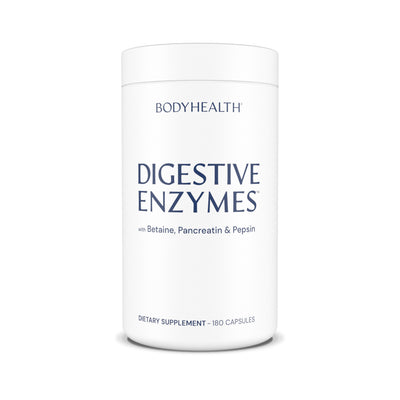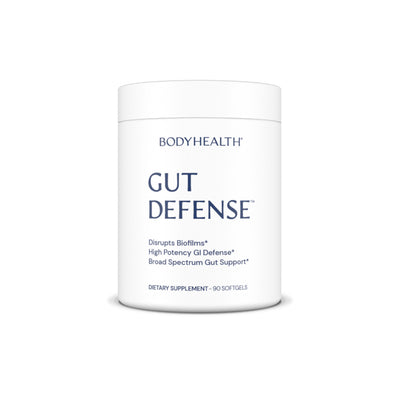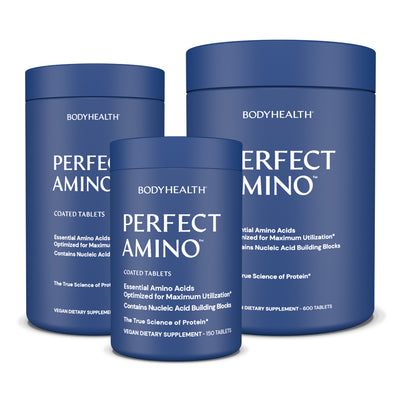The Importance Of Complete Protein Digestion
March 20, 2024 8 min read

Your digestive tract’s ability to fully digest and absorb protein determines, in large part, your body's ability to build muscle and lose body fat.
It also affects our energy levels, hormones, inflammatory response, and overall health.
When protein isn’t properly digested, this triggers a sequence of actions, involving our immune system, which leads to higher levels of cortisol, the hormone that prevents fat loss and breaks down muscle.
Even more, without full digestion, our body receives less of the protein we consume in a form it can actually use.
So we get less protein for muscle, properly balanced hormones, and overall health and energy, while at the same time we’re eating more that goes to waste.
This is a big deal. Due to processed foods and sugars, many of our digestive tracts don’t function at optimal levels, preventing a significant amount of the food we eat from being fully broken down so our body can use it.
Beyond this, improper digestion leads to not only heart burn, acid reflux, GERD, and gas and bloating, but also allows for harmful bacteria, parasites, and fungi to take root, further causing us trouble.
Everything hinges on protein.
So, understanding exactly how digestion works and how to keep or get it working properly is very important.
UNDERSTANDING THE DIGESTIVE PROCESS OF PROTEIN
When you consume food, you chew it, swallow it, and it goes into your stomach.
Here we see mostly protein digestion, with fats and carbs mainly digested in the small intestine.
When protein makes its way into your stomach, it releases two main things: hydrochloric acid, or stomach acid, and an enzyme called pepsin.
This stomach acid does a few things: it helps break down proteins and minerals necessary for later protein synthesis in the body; and it kills bacteria, fungi, parasites, and viruses coming in with your food and water.
Now, these proteins you ate are each made of hundreds or thousands of individual amino acids, all bonded together in long chains like a beaded thread and then coiled up, with the coils also bonded together to hold it all together as a "protein."
So first, the stomach acid breaks the bonds holding the coils together, so it’s one long chain. Then the pepsin starts breaking the bonds that hold the overall chain together. It doesn’t break all of them, but it breaks most. So by the end of this, instead of each protein molecule being a long chain of hundreds or thousands of amino acids, it’s now broken up into many much smaller chains of maybe 20 to 40 amino acids each.
While this is happening, the level of stomach acid has been rising. By the time these amino acid chains are broken up, the stomach acid should have reached a pH level of about 1 or 2. The stomach can handle this level of acid because of a mucous lining it has along its walls.
But it needs to get to a pH of 1 or 2 because this is the trigger that signals the valve between the stomach and small intestine to open and let the food through. If the stomach acid didn’t get this acidic, then the food would stay in the stomach much longer and go rancid. Then it would start bubbling up and burn the esophagus, which isn’t made to handle this acid. This is heartburn and acid reflux when there’s not enough stomach acid — not when there’s too much.
So we want it very acidic. If it’s not, then you get heartburn, but also, you get proteins that aren’t broken down enough.
From here, the food moves into the small intestine where more enzymes come in, further breaking these short amino acid chains up until they’re individually free-floating — no more beaded threads, just beads.
Other enzymes also start breaking down the fats and carbohydrates, and all of these broken down pieces start moving through the intestinal wall into blood vessels that take them to the liver. The liver then filters all of this, looking for any toxins which it tags so the kidneys know to get rid of them, and then lets it all out into the bloodstream.
But this protein breakdown is important here. The amino acid chains must be fully broken down into individual amino acids for a few reasons.
First, if they are fully broken down, then the body can use them to build new proteins and collagen in the forms it needs for muscle, bone, hormones, enzymes, etc.
If they’re not fully broken down, the body can’t use them at all.
In this case, they continue through the digestive system and leave the body as waste, or they’re absorbed into the bloodstream and cause inflammation in the body.
This is because of those bacteria, fungi, parasites, and viruses I mentioned coming in with your food, also known as foreign invaders — because they are your enemy.
WHAT YOUR IMMUNE CELLS DO
Your small intestine is surrounded by three walls. The first is an inner lining about one cell in thickness which sees the broken down nutrients and lets them through. The third wall is all the blood vessels surrounding the intestine which take these nutrients to the liver. But the second wall, between these two, is made of immune tissue. Lymph tissue, to be exact.
This is why you’ve heard that about 80% of your immune system is in your gut.
When food comes into the small intestine, this lymph tissue sends out immune cells to check for any foreign invaders. When the immune cells find some, they send antibodies to surround and destroy them.
This is an immune response and there’s always some inflammation during an immune response. So if there were a lot of bacteria, like salmonella poisoning, you might get a bellyache as an immune response.
Remember, any protein the body needs is already broken down into individual amino acids at this point. So these whole protein structures (bacteria, parasites, etc.) must be foreign invaders.
The antibodies either kill them or some may make it into the bloodstream and land somewhere in the body, in which case the immune cells go there to kill them. And in this case, we feel inflammation at the spot where they landed due to the immune response.
The immune cells also remember the exact protein structure of these invaders so they remember them in the future. They do this so they don’t mistake the body’s own protein structures for harmful bacteria and attack them (that’s what an auto-immune disease is — when the body mistakes itself for harmful invaders and attacks itself).
Now look at this... if your digestive system didn’t fully break down all your protein into individual amino acids and some of the partial amino acid chains got out into the bloodstream, then it knows they aren’t individual aminos or bodily protein structures and assumes they are harmful bacteria.
This launches an immune response against these partially broken down proteins, and immune responses cause inflammation.
Now, if this happens on a daily basis because you have low stomach acid, it causes a continually created inflammation in the body wherever these partial proteins landed.
This creates an extra load on your immune system, which is needed for muscle building and overall health. The extra load also results in continual stress on the body, which means a continual release of cortisol.
WHY A HEALTHY DIGESTIVE SYSTEM IS IMPORTANT
If we have low stomach acid levels, and more harmful bacteria make their way into the small intestine without being killed in the stomach, they can take root in the intestine and grow. It’s not acidic there, it’s dark and it’s warm so they start to consume some of the food you ate.
What do they give you in return? Gas and bloating.
Safe to say they’re not good tenants.
But now, not only are you losing some of the protein you ate due to it not being fully broken down, you’re also losing it to these bacteria who eat some of it, and to cortisol released due to inflammation, which breaks down muscle and increases fat storage.
This may seem small. It's not.
It affects our hormones, energy levels, hunger cravings, and our ability to gain and lose muscle and fat.
If we don’t get all the food that we’re consuming because it’s not broken down enough, or it’s being consumed by bacteria and parasites, then we’ll still be hungry even if we eat a lot.
We’ll have cravings created by these bad bacteria, especially for fast-acting sugar, which can raise fat storage, and we’ll have less amino acids for building muscle, making hormones that direct our body to build muscle, and for enzymes that break down our fat.
These chemicals are made, perform their function, and are then gone. They need to be constantly replaced inside the body.
So we need these proteins fully broken down and we need these bacteria killed off.
This is one reason PerfectAmino is so effective. It’s already fully broken down so that, no matter the state of your digestive tract, you’re getting all of that protein.
Most people have some degree of lowered digestive acid these days, causing plenty of trouble in their bodies. In fact, this is one of the biggest causes of muscle loss as we get older — lowered digestive ability.
So if you experience indigestion, heartburn, GERD, or gas and bloating, beyond taking PerfectAmino, I highly recommend you get our Digestive Enzymes to ensure your body is fully breaking down proteins, killing harmful bacteria, and giving your body what it needs to function and thrive.
I know that was long, and we touched on several points. Over the next several articles, we’ll dive deeper into acid reflux, bacterial infections, prevention of muscle loss, auto-immune conditions, how digestion affects our mood, as well as cravings.
I hope this helps.
And if you haven’t seen the Lean Body/Lean Bulk Program, check it out and do the 30-Day Challenge. It’s very effective.
And make sure to join our VIP Group where you can ask any question you have and get only the best answers.
Index To The Lean Body/Lean Bulk Guide:
Introductory Articles:
Getting Started:
- The Lean Body/Lean Bulk Guide & 30-Day Challenge
- Hormones: The Third Dimension of Calorie Cutting
- The Lean Body/Lean Bulk Diet
Supplements & Macros By Goal:
- Supplements & Macros For Lean Body
- Supplements & Macros For Beginner To Moderate Lean Bulking
- Supplements & Macros For Advanced Lean Bulking
Workout Regimens & Exercise Videos:
- Beginner to Moderate Level Workout Regimen
- Advanced Workout Regimen
- Lean Body/Lean Bulk Exercise Videos
Week One:
- Metrics & Key Data For Week One
- How BCAAs Build Body Fat & Lower Health Over Time
- The Importance Of Complete Protein Digestion
Week Two:
- Dialing In Our Macros For Lean Muscle: Hormones & Cravings
- How Cortisol Breaks Down Muscle & Prevents Protein Synthesis
- How To Improve Growth Hormone, Testosterone & Protein Synthesis
Week Three:
- Thyroid, Estrogen & Progesterone: Speeding Fat Loss & Lean Muscle Creation
- Improving Sleep: Muscle Building, Fat Loss, Mood & Aging
- Maximizing Cellular Function For Endurance & Recovery
Week Four:
- Raising VO2 Max: Endurance, Performance & Recovery
- How Toxins Affect Our Hormones: Building Muscle & Fat Loss
- Blood Flow For Muscle, Fat Loss & Overall Health
Final Week:
Articles by Health Topic
Your Path To Better Health Starts Here!
From in-depth articles on nutritional benefits to updates on new product launches, stay informed and inspired on your journey to optimal health.
*These statements have not been evaluated by the Food and Drug Administration. These products are not intended to diagnose, treat, cure, or prevent any disease.




